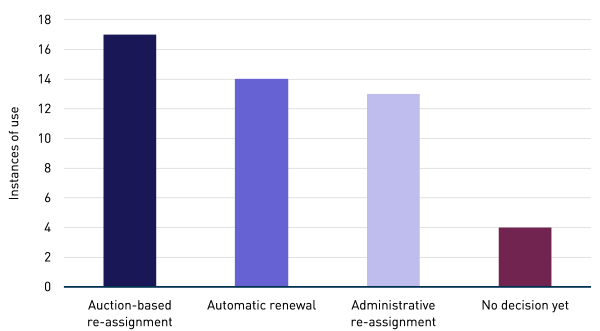The four critical policy criteria for mobile spectrum renewal
In many countries, 15- to 20-year GSM licences issued in the late 1990s are coming up for renewal. In addition, the first UMTS licences have already started to expire. Licence expirations offer national regulatory authorities (NRAs) the opportunity to realise multiple primary policy objectives relating to spectrum management while addressing secondary issues such as spectrum refarming or ensuring contiguity of spectrum holdings.
However, licence renewals are a time of high tension between NRAs, incumbents and potential market entrants, all of which are likely to have divergent opinions on the most appropriate approach to re-licensing the spectrum. Regulators risk harming competition, interrupting services, discouraging investment, being seen as biased or enabling (the continuation of) an inefficient spectrum distribution. Operators, on the other hand, risk paying excessive licence fees, receiving too little high-value spectrum relative to competitors and being unable to provide a consistent service. This article examines the various approaches to spectrum re-licensing and the criteria NRAs should consider when evaluating different approaches.
Regulatory options
Benchmarking the action taken upon expiry of mobile spectrum licences across 43 countries since 2006, we have found that regulators use three main categories of approach, with similar frequency.
- Automatic renewal, whereby the current licence-holder retains the spectrum licence. This can come about through the issuance of indefinite licences, or where there is an implicit high expectation of renewal.
- Administrative re-assignment to another operator.
- Auction-based approaches, whereby either the current licence-holder or another operator can obtain the licence. As well as full auctions of all expiring spectrum licences (with or without the prior harmonisation of the expiry dates of licences), hybrid approaches whereby part of the available spectrum has licences renewed with part of it auctioned, or where a licence-holder retains a first right of purchase can be used.
Figure 1: Instances of approaches used for spectrum licence renewal, 43 countries, 2006–2013 [Source: Analysys Mason, 2014]

Policy objectives
Given the high stakes of licence re-assignment, it is imperative that regulators decide on a re-assignment approach only after carefully evaluating their policy objectives, assessing the extent to which these objectives are currently being met and considering how different potential approaches will affect these objectives in the future.
To this end we have identified the following four criteria that NRAs might want to consider when evaluating licence renewal approaches, noting that some regulators may also be concerned with the amount of revenue to be raised and the complexity of the process:
- market competitiveness and efficiency
- investment-friendliness and service continuity
- spectrum manageability
- the transparency and fairness of award.
Each of the re-licensing approaches identified has a different effect on the policy objectives that are likely to be of interest to regulators.
- Automatic renewal regimes are investment-friendly, but result in low levels of manageability. In addition, as with administrative re-assignment, complicated issues such as how much to charge for the spectrum may arise, as Ofcom is currently consulting on with regard to 900MHz and 1800MHz licences in the UK.
- Administrative re-assignment procedures allow for maximum manageability and can be pro-competitive, but are prone to regulatory failure. In particular, this manageability may be achieved at the cost of decreased investment incentives and minimal transparency.
- Auction-based approaches ensure high levels of competition and are generally transparent and fair. However, the uncertainty they introduce for operators may dampen investment incentives, while manageability and potentially service continuity are also reduced.
Conclusions: NRAs should choose an approach to expiring licences based on their market situation and policy objectives
In our view there is no single ‘right answer’ for an NRA and the approach to be followed should be very carefully considered in light of the individual market situation and the particular policy objectives being followed.
Administrative re-assignment approaches may be advisable at times when the NRA needs to maintain close control of national spectrum distribution because of technological changes or changing market dynamics. On the other hand, automatic renewal lacks the flexibility to react to significant market changes but may be more appropriate if the initial distribution of spectrum was competitive, transparent and fair (for example, via auction).
Auctions are best if the NRA wishes to re-assign licences from a ‘clean slate’, with a long timeframe and does not expect any major changes in the future value of the auctioned spectrum that would require regulatory intervention. Hybrid auction-based approaches with harmonisation of expiry, first right of refusal to incumbents or incorporating only part of the spectrum may offer increased levels of manageability, service continuity and investment incentives while continuing to aid competition and offering varying degrees of transparency. These approaches may become increasingly attractive for regulators, in our opinion.
Analysys Mason is a leading advisor to operators and regulators on spectrum valuation, spectrum auctions and all spectrum management-related matters. For more information about our services, please contact Mark Colville, Senior Manager, at mark.colville@analysysmason.com.
Downloads
Article PDFAuthors


